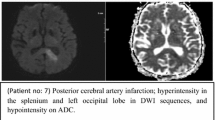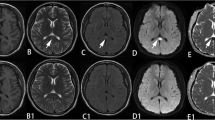Abstract.
Transient focal lesions in the splenium of the corpus callosum have been reported in epileptic patients receiving antiepileptic drugs. The characteristic imaging features included an oval high signal lesion on T2-weighted images in the central part of the splenium, no enhancement on post-contrast MR images, and complete reversibility without specific treatment. We report identical MR imaging findings in a depressive patient who had received antiepileptic drugs. In addition, diffusion-weighted MR imaging findings are described in our case, which is the first report on this unique lesion associated with antiepileptic drugs. Although this lesion has been assumed to be vasogenic edema in the previous reports, diffusion-weighted MR imaging showed markedly restricted diffusion of the lesion in the present case, suggesting that cytotoxic edema was the main pathophysiological abnormality.


Similar content being viewed by others
References
Friese SA, Bitzer M, Freudenstein D, Voigt K, Küker W (2000) Classification of acquired lesions of the corpus callosum with MRI. Neuroradiology 42:795–802
Kim SS, Chang KH, Kim ST et al. (1999) Focal lesion in the splenium of the corpus callosum in epileptic patients: antiepileptic drug toxicity? Am J Neuroradiol 20:125–129
Polster T, Hoppe M, Ebner A (2001) Transient lesion in the splenium of the corpus callosum: three further cases in epileptic patients and a pathophysiological hypothesis. J Neurol Neurosurg Psychiatry 70:459–463
McDonald WI, Compston A, Edan G et al. (2001) Recommended diagnostic criteria for multiple sclerosis: guidelines from the international panel on the diagnosis of multiple sclerosis. Ann Neurol 50:121–127
Shelton RC (1999) Mood-stabilizing drugs in depression. J Clin Psychiatry 60:37–40
Chason DP, Fleckenstein JL, Ginsburg MI, Mendelsohn DB, Mathews D (1996) Transient splenial edema in epilepsy: MR imaging evaluation. Annual Meeting of the American Society of Neuroradiology, 21–27 June, Seattle
Gotman J (1991) Seizure spread. In: Luders H (ed) Epilepsy surgery. Raven, New York, pp 349–354
Schaefer PW (2000) Diffusion-weighted imaging as a problem-solving tool in the evaluation of patients with acute strokelike syndromes. Top Magn Reson Imaging 11:300–309
Schwarz RB, Mulkern RV, Gudbjartsson H, Jolesz F (1998) Diffusion-weighted MR imaging in hypertensive encephalopathy: clues to pathogenesis. Am J Neuroradiol 19:859–862
Warach S, Gaa J, Siewert B, Wielopolski P, Edelman RR (1995) Acute human stroke studied by whole brain echo planar diffusion-weighted magnetic resonance imaging. Ann Neurol 37:231–241
Liu AY, Maldjian JA, Bagley LJ, Sinson GP, Grossman RI (1999) Traumatic brain injury: diffusion-weighted MR imaging findings. Am J Neuroradiol 20:1636–1641
Lansberg MG, O'Brien MW, Norbash AM, Moseley ME, Morrell M, Albers GW (1999) MRI abnormalities associated with partial status epilepticus. Neurology 52:1021–1027
Cramer SC, Stegbauer KC, Schneider A, Mukai J, Maravilla KR (2001) Decreased diffusion in central pontine myelinolysis. Am J Neuroradiol 22:1476–1479
Fujikawa A, Tsuchiya K, Katase S, Kurosaki Y, Hachiya J (2001) Diffusion-weighted MR imaging of carmofur-induced leukoencephalopathy. Eur Radiol 11:2602–2606
Tievsky AL, Ptak T, Farkas J (1999) Investigation of apparent diffusion coefficient and diffusion tensor anisotropy in acute and chronic multiple sclerosis lesions. Am J Neuroradiol 20:1491–1499
Ogura H, Takaoka M, Kishi M et al. (1998) Reversible MR findings of hemolytic uremic syndrome with mild encephalopathy. Am J Neuroradiol 19:1144–1145
Acknowledgement.
The authors thank Y. Miki for his invaluable assistance.
Author information
Authors and Affiliations
Corresponding author
Rights and permissions
About this article
Cite this article
Maeda, M., Shiroyama, T., Tsukahara, H. et al. Transient splenial lesion of the corpus callosum associated with antiepileptic drugs: evaluation by diffusion-weighted MR imaging. Eur Radiol 13, 1902–1906 (2003). https://doi.org/10.1007/s00330-002-1679-5
Received:
Revised:
Accepted:
Published:
Issue Date:
DOI: https://doi.org/10.1007/s00330-002-1679-5




